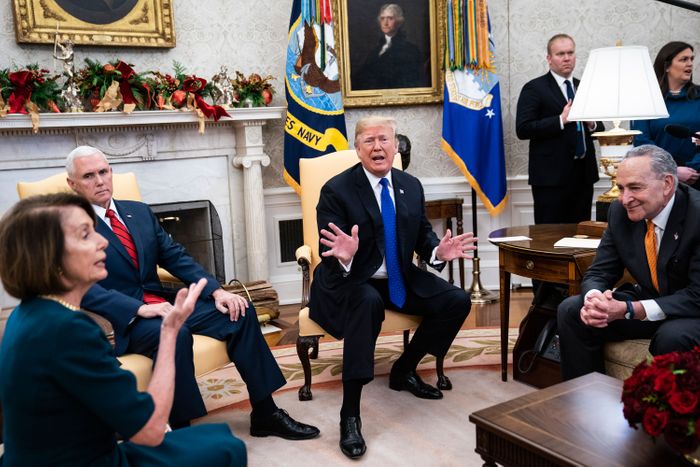
The Trump administration’s shutdown of the federal government over the last two weeks is a synecdoche for the way it has run the federal government over the last two years. They blundered into it almost by accident, without any understanding of what they are doing nor any plan for success.
Just as Trump did not expect to win the election and neglected to plan for his transition, he shut down the government on a whim, after right-wing media complained about his plan to approve a government funding bill. Nobody in the administration had a clear understanding of just what a shutdown would entail. Two devastating reports in the Washington Post over the weekend detail the horrifying scope of their ignorance. The administration did not realize that 38 million Americans lose their food stamps under a shutdown, nor did it know that thousands of tenants would face eviction without assistance from the Department of Housing and Urban Development.
Administration officials “recognized only this week the breadth of the potential impact,” reports the Post, and was “focused now on understanding the scope of the consequences and determining whether there is anything they can do to intervene.” First Trump shut down the government, and then the Trump administration started looking into what effect this would have.
It’s likely the administration was lulled into complacency by a previous, abbreviated shutdown that took place in early 2018. This interruption in funding lasted only a few days and had barely any effect. Perhaps the administration assumed a longer shutdown would work the same way, but, you know, more of it. The reality is that the effects of a shutdown compound over time. Government agencies can creatively stretch their budgets to mask gaps in funding, but at some point, their capacity to maintain services snaps. The relationship between the length of a shutdown and its impact is not linear. A 30-day shutdown is not ten times as damaging as a three-day shutdown. It is probably 100 times as damaging.
The impending reality of millions of Americans going hungry and homeless is just one aspect of the horrors that await us. At some point, the shutdown will impinge upon Trump’s C-suite constituency. Employees of the Transportation Security Administration have had to work without pay, but that cannot continue indefinitely. Already, employees at some airports have begun staging sick-outs. At some point, air travel will grind to a halt, and with it large segments of the economy. By next month, tax refunds will be in jeopardy.
Facing an economic cataclysm, Trump appears to have no endgame in mind. He told Senate Minority Leader Charles Schumer he would “look foolish” if he agreed to reopen the government without extracting concessions. But Democrats have no incentive to give him any. Voters in general tend to blame the president for problems. This holds true even when Congress is responsible for the problems, but it especially holds true when the president personally engineers the calamity and announces beforehand on camera that he won’t blame the other side for it.
One path for the administration to escape the vise it has created for itself is to negotiate an immigration deal. Jared Kushner is reportedly trying to craft a bargain that would swap protection for Dreamers in return for border-security funding. In theory, members of both parties support a deal like this. But this kind of enforcement-plus-amnesty trade formed the basis of immigration reform deals that failed under both George W. Bush and Barack Obama’s presidencies. Immigration reform is really hard to do. The notion that broadening the negotiations to include a divisive social policy that had repeatedly defied compromise would make it easier to reopen the government seems fanciful.
As difficult as immigration reform always is, Trump’s fixation with the wall compounds the difficulty. The wall is not a product of conservative immigration policy, it’s a messaging device devised by Trump’s campaign to get him to discuss immigration and to help him stand out from other anti-immigration conservatives. Immigration restrictionists like Mark Krikorian and Heather MacDonald frankly tell the New York Times they don’t care about the wall. Krikorian frets about the “danger that [Trump] would trade almost anything in order to get the wall.” MacDonald laments that the wall “has sucked political capital from the pursuit of other, and arguably better, means to deter illegal immigrants,” as MacDonald wrote.
The anti-immigration right does not oppose the wall, they simply don’t consider it especially useful as a tool to reduce illegal immigration. (Because it is not.) Therefore, from the restrictionist standpoint, any deal that trades something liberals want for the wall is a net negative.
Just how long will it take for Trump to figure out that he is probably not the president who is going to break America’s long-standing immigration policy deadlock? Probably longer than he can bear the political pain that his shutdown is bringing upon himself and his party. Democrats might be tempted to hand Trump a token ransom to end the very real pain of the shutdown. But to do so would invite further hostage-taking. All they can do in the meantime is continue to send Trump bills to reopen the government immediately, and wait for the president to realize the political blood on the floor is his own.






























